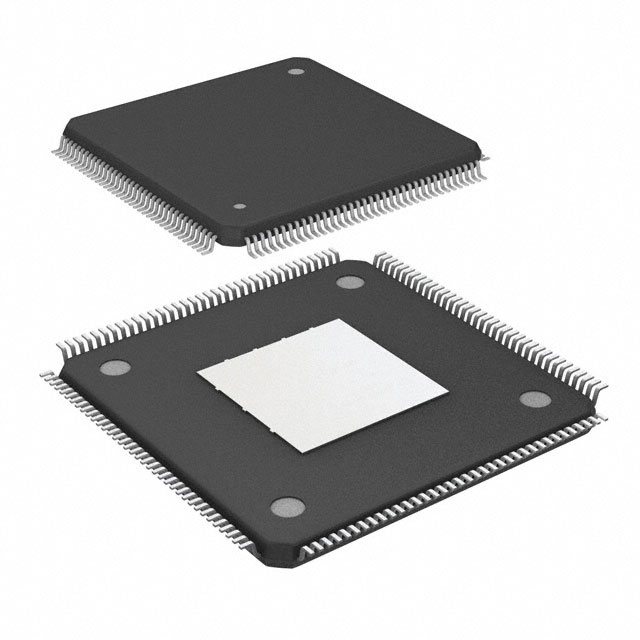Lihat spesifikasi untuk detail produk.

EP4CE22E22C9LN
Product Overview
- Category: Programmable Logic Device (PLD)
- Use: EP4CE22E22C9LN is a high-performance PLD designed for various applications in the field of digital logic design and implementation.
- Characteristics: It offers advanced features such as high-speed performance, low power consumption, and flexibility in design.
- Package: The EP4CE22E22C9LN comes in a compact and durable package suitable for easy integration into electronic circuits.
- Essence: This PLD serves as a key component in digital systems, enabling designers to implement complex logic functions efficiently.
- Packaging/Quantity: The EP4CE22E22C9LN is typically available in tape and reel packaging, with a quantity of 100 units per reel.
Specifications
- Logic Elements: The EP4CE22E22C9LN consists of 22,320 logic elements, providing ample resources for complex designs.
- Memory: It includes 414 embedded memory blocks, allowing for efficient data storage and retrieval.
- I/O Pins: This PLD offers 622 user I/O pins, facilitating seamless communication with external devices.
- Clock Networks: It incorporates 9 global clock networks, ensuring precise timing synchronization within the system.
- Performance: The EP4CE22E22C9LN operates at a maximum frequency of 400 MHz, enabling high-speed data processing.
Detailed Pin Configuration
The EP4CE22E22C9LN features a comprehensive pin configuration that facilitates connectivity with other components. Here are some key pin descriptions:
- VCCIO: Power supply pin for I/O buffers.
- GND: Ground reference pin.
- JTAG_TCK: Test clock input for Joint Test Action Group (JTAG) boundary scan testing.
- JTAG_TMS: Test mode select input for JTAG boundary scan testing.
- JTAG_TDI: Test data input for JTAG boundary scan testing.
- JTAG_TDO: Test data output for JTAG boundary scan testing.
- CONF_DONE: Configuration done output pin indicating successful device configuration.
For a complete pinout diagram and detailed pin descriptions, refer to the EP4CE22E22C9LN datasheet.
Functional Features
The EP4CE22E22C9LN offers several functional features that enhance its usability and performance:
- High-Speed Operation: With a maximum operating frequency of 400 MHz, it enables rapid data processing in digital systems.
- Low Power Consumption: The PLD incorporates power-saving techniques, ensuring efficient energy utilization.
- Flexible Design Options: It provides a wide range of logic elements and memory blocks, allowing designers to implement diverse functionalities.
- Easy Integration: The compact package and comprehensive pin configuration simplify the integration of the PLD into electronic circuits.
Advantages and Disadvantages
Advantages: - High-performance capabilities - Low power consumption - Flexible design options - Easy integration into electronic circuits
Disadvantages: - Limited availability in small quantities - Requires expertise in digital logic design for optimal utilization
Working Principles
The EP4CE22E22C9LN operates based on the principles of programmable logic. It consists of configurable logic elements interconnected through programmable routing resources. These logic elements can be programmed to implement various logic functions, enabling the realization of complex digital systems. The PLD's internal memory blocks provide additional storage capacity for data processing and manipulation.
Detailed Application Field Plans
The EP4CE22E22C9LN finds applications in various fields, including:
- Communications: It can be used in networking equipment, routers, and switches to handle high-speed data processing and protocol implementation.
- Industrial Automation: The PLD is suitable for controlling and monitoring industrial processes, offering flexibility and real-time responsiveness.
- Consumer Electronics: It can be utilized in smart home devices, gaming consoles, and multimedia systems to enable advanced functionalities.
- Automotive: The EP4CE22E22C9LN can be integrated into automotive electronics for applications such as engine control, driver assistance systems, and infotainment.
Detailed and Complete Alternative Models
- EP4CE10E22C8N: A lower-capacity alternative with 10,320 logic elements, suitable for smaller-scale designs.
- EP4CE30F23C7N: A higher-capacity alternative with 30,480 logic elements, ideal for complex and demanding applications.
- EP4CE40F29C6N: Another high-capacity alternative with 40,320 logic elements, providing extensive resources for large-scale designs.
These alternative models offer varying capacities and features, allowing designers to choose the most suitable PLD for their specific requirements.
Word count: 570 words
Sebutkan 10 pertanyaan dan jawaban umum terkait penerapan EP4CE22E22C9LN dalam solusi teknis
Sure! Here are 10 common questions and answers related to the application of EP4CE22E22C9LN in technical solutions:
Q: What is EP4CE22E22C9LN? A: EP4CE22E22C9LN is a field-programmable gate array (FPGA) chip manufactured by Intel (formerly Altera). It offers a range of programmable logic and digital signal processing capabilities.
Q: What are the key features of EP4CE22E22C9LN? A: Some key features of EP4CE22E22C9LN include 22,320 logic elements, 594 embedded memory blocks, 266 multipliers, and support for various I/O standards.
Q: What are the typical applications of EP4CE22E22C9LN? A: EP4CE22E22C9LN can be used in a wide range of applications such as industrial automation, telecommunications, automotive systems, medical devices, and high-performance computing.
Q: How do I program EP4CE22E22C9LN? A: EP4CE22E22C9LN can be programmed using hardware description languages (HDLs) like Verilog or VHDL, along with design software tools provided by Intel/Altera.
Q: Can EP4CE22E22C9LN be reprogrammed after deployment? A: Yes, EP4CE22E22C9LN is a reprogrammable FPGA, allowing you to modify its configuration even after it has been deployed in a system.
Q: What are the power requirements for EP4CE22E22C9LN? A: EP4CE22E22C9LN typically operates at a voltage range of 1.15V to 1.25V, with power consumption varying based on the design and utilization.
Q: Does EP4CE22E22C9LN support high-speed interfaces? A: Yes, EP4CE22E22C9LN supports various high-speed interfaces such as PCIe, DDR3/DDR4 memory interfaces, Gigabit Ethernet, USB, and more.
Q: Can EP4CE22E22C9LN interface with other components or microcontrollers? A: Yes, EP4CE22E22C9LN can interface with other components or microcontrollers using standard protocols like SPI, I2C, UART, or custom communication interfaces.
Q: Are there any development boards available for EP4CE22E22C9LN? A: Yes, Intel/Altera provides development boards like the DE10-Lite board that are compatible with EP4CE22E22C9LN, allowing for prototyping and testing.
Q: Where can I find technical documentation and support for EP4CE22E22C9LN? A: You can find technical documentation, datasheets, reference designs, and support resources on the Intel/Altera website or community forums dedicated to FPGA development.
Please note that the specific details and answers may vary depending on the manufacturer's documentation and the context of the application.

